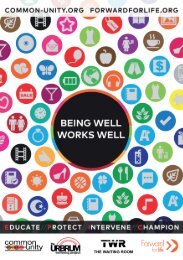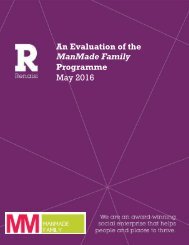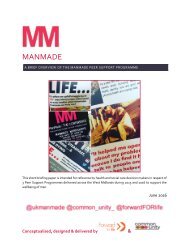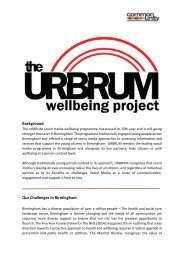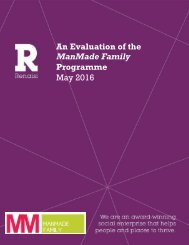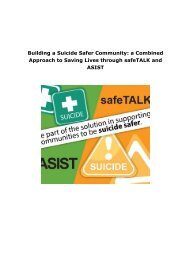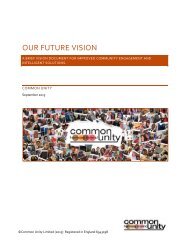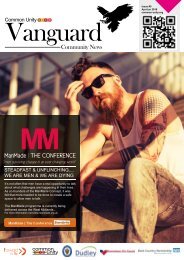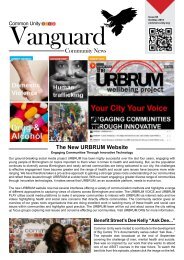URBThe Information Chasm_January2017_B
Create successful ePaper yourself
Turn your PDF publications into a flip-book with our unique Google optimized e-Paper software.
Author: Caron Thompson // Company Director // Common Unity<br />
Date: October 10th 2016
What is Urbrum?<br />
Urbrum, as a web based community centred platform, is all about discovering innovative ways of<br />
engaging communities with their own health and wellbeing and the health and well-being of those<br />
around them. Its approach to engagement, information and intelligence sees communities as both the<br />
recipients and providers of health and well-being intelligence with a view that through such an organic<br />
process, services and support will continue to best reflect what communities need and want.<br />
The <strong>Information</strong> <strong>Chasm</strong>.<br />
In the world of Health and Social Care communication, one of the biggest ongoing challenges being<br />
faced has been what we call at Common Unity “The <strong>Information</strong> <strong>Chasm</strong>.” This chasm sits squarely<br />
between those who provide on the one side, and those who would receive on the other. But the size<br />
of this chasm means that by the time information about any form of support is received by the citizens<br />
and cascaded to their wider communities, the information is either out of date because the services<br />
have shut down or have been changed significantly regarding their admission criteria and contact<br />
details – It appears that however hard the tenacious Database Administrators work to sift information,<br />
build service links and keep on top of all services, their best efforts more often than not go to waste.<br />
Such a situation causes a huge level of dissatisfaction for those who need a service but are either<br />
finding out too late for it to be of benefit or find themselves unable to make contact due to a range of<br />
key service communication changes. This chasm, is one key reason why accessible services are often<br />
not accessible at all and is also a cause of much frustration across communities to the point that many<br />
citizens just give up.<br />
The current approach of building, piece by piece, a database of local services and populating that<br />
database with checked and double checked information in respect of names, numbers, service details<br />
and location, as well as the ongoing management of that data, is staff resource heavy, time consuming<br />
and limited due to the fact that only the organisations that have the money<br />
(administration/management/membership fees), benefit of the time and the inclination to engage<br />
with such a process will be highlighted.<br />
What is the URBRUM Key About?<br />
The Urbrum Resource Key provides an alternative approach to taking control of our own health and<br />
well-being – it is a virtual bridge across “The <strong>Information</strong> <strong>Chasm</strong>” that connects support services to<br />
the recipient almost instantly – the Urbrum Resource Key by engaging citizens with sources of support<br />
directly and seamlessly is, in its own right an intervention, taking away the often wearisome process<br />
of finding the right place to get help – an online resource library of information and support that can<br />
be navigated with minimum difficulty. In addition, the ongoing management of the process is<br />
relatively small but engagement can be realised at high levels and monitored effectively.
The resource key does all this through adhering to a few simple principles:<br />
1) To be innovative in technology we don’t have to invent – we just need to redefine or<br />
refine existent technologies that are relatively inexpensive, or better still, free and<br />
serve a useful purpose.<br />
2) Make access to this technology easy and discreet through a convenient access route<br />
housed within a long-lasting product.<br />
3) Don’t waste time and resources building new data from scratch – use existent web<br />
based data and from this framework develop the portfolio over time to best target<br />
communities and meet local need.<br />
4) Recognise that informed choice is paramount for citizens in realising their own health<br />
and well-being – the resource key is all about informed choice.<br />
The Technical Bit - Usage<br />
In August 2015 Ofcom reported that the UK is officially a smartphone society with over two-thirds of<br />
the adult population owning a smartphone and a similar projection being estimated in respect to<br />
tablet ownership by 2016. The virtual world with access to up to the minute information is fast<br />
becoming the accepted norm and there is no indication of this phenomenon slowing.<br />
This rise in smartphone surfing marks a clear shift since 2014, when just 22% turned to their phone<br />
first, and 40% preferred their laptop.<br />
In fact, Smartphones have become the hub of our<br />
daily lives and are now in the pockets of 66% of<br />
UK adults, up from 39% in 2012. The vast majority<br />
(90%) of 16-24 year olds own one; but 55-64 year<br />
olds are also joining the smartphone revolution,<br />
with ownership in this age group more than<br />
doubling since 2012, from 19% to 50%.<br />
The surge is further being driven by the<br />
increasing take-up of 4G mobile broadband,<br />
providing faster online access.<br />
We now spend almost twice as long online with our smartphones than on laptops and personal<br />
computers. On average, mobile users spent nearly two hours online each day using a smartphone in<br />
March 2015 (1 hour and 54 minutes), compared to just over an hour spent online by laptop and PC<br />
users (1 hour and nine minutes).
The Technical Bit – Quick Response (QR) Codes<br />
Through scanning a QR Code via your tablet or smart phone app (free to download), the user is taken<br />
to a pre-determined website – it is currently used for a range of commercial purposes particularly in<br />
respect of marketing, promotion, commercial tracking, entertainment and transport as well as<br />
ticketing. The beauty of QR codes is that they are easy to produce and reproduce being displayed<br />
almost anywhere. This means that access to a specific website for a specific purpose through a specific<br />
QR code could be printed in a range of formats and a range of places for a number of different target<br />
groups.<br />
The Urbrum Resource Key (The Waiting Room Resource Key)<br />
Common Unity have spent many years helping to<br />
develop and produce eye catching directories, “Z-<br />
Cards”, Wallet Cards, glossy leaflets and magazines<br />
in a bid to best engage vulnerable communities<br />
with services that can best support their needs.<br />
Unfortunately, because of the “<strong>Information</strong><br />
<strong>Chasm</strong>” described earlier the shelf life of such<br />
products is extremely limited to the extent that<br />
often when the product has been printed and<br />
delivered, much of the information is already out<br />
of date.<br />
When you add to this the cost incurred regarding the design, development, distribution and staff<br />
resources – the whole process is pretty much an exercise in information futility. Furthermore, paper<br />
based information just does not last and more often than not finds itself banished to the deepest<br />
darkest corner of the sofa or becomes a paper aeroplane for the children or worse still never makes it<br />
out of the back pocket before the next washing cycle.<br />
The Urbrum Resource Key, being a durable key fob with an embedded QR code, answers these<br />
challenges head on in respect of durability, practicality and cost.
Where Does the QR Code Take You?<br />
Back in the 1990’s in Sheffield a forward thinking local newspaper owner realised that there was a<br />
huge profitable opportunity to be grasped in respect of GP Surgery waiting rooms being places with a<br />
significant weekly footfall - the ‘captive audience’ being made up by patients. Magazines available<br />
had historically been donated by the patients and although relieving some of the boredom whilst<br />
waiting for an appointment, these magazines were typically many months, if not years, out of date.<br />
This local newspaper owner realised that through investment from pharmaceutical companies for<br />
advertising (being allowed back then), a weekly magazine could be distributed across the GP practices<br />
with good profit to be made from the private sector investment. This newspaper was called The<br />
Waiting Times.<br />
It is on the basis of this idea that the Urbrum virtual Waiting Room was born; A section within Urbrum<br />
that gives the public access to up to date health and wellbeing information that supports them in<br />
understanding and even dealing with challenges that may be troubling them or their family, friends<br />
and community.<br />
With an emphasis on protect and prevent, The Waiting Room couch is split into a number of key areas<br />
and by clicking on a key area, will take the smartphone reader through to a list of local and national<br />
websites and contact numbers (fully accessible) that can be accessed for the purposes of information<br />
and direct support.
The following link takes you to a youtube video<br />
that shows exactly how the QR Code works for<br />
the Urbrum Resource Key -<br />
https://youtu.be/EHtzrl4Ua30 or you can just<br />
click on the picture if you have the necessary<br />
access rights on your PC.<br />
It is envisaged that The Waiting Room, a place<br />
that already offers some signposting, will be<br />
supported to continuously develop to best<br />
enable vulnerable community members<br />
instant and discreet access to appropriate local<br />
and national support services as well as up-todate<br />
and useful information to help protect<br />
citizens and prevent life damaging events from<br />
occurring. In effect, Common Unity want The<br />
Waiting Room to be the One Stop Virtual Shop<br />
for Birmingham people – so they know where<br />
to go, who to see or what to do to best support<br />
their own needs in an ever challenging world.<br />
With The Waiting Room being part of Urbrum, a Web-Site specifically developed to realise improved<br />
engagement and understanding between communities and decision makers as well as promote a<br />
greater shared sense of identity and ownership of Birmingham – The Waiting Room is situated in a<br />
perfect space for supporting people to better support themselves and their communities.<br />
What Are the Opportunities for This Approach?<br />
The opportunities for Urbrum Resource key are many but will only be realised with investment both<br />
in respect of time, development opportunities and close partnership working.<br />
1) The well-being agenda:<br />
The resource key as a front-virtual intervention has great possibilities. Public Health would be in<br />
the position of targeting information to specific vulnerable communities providing them with<br />
instant access through the Waiting Room to vital local and national information that can support<br />
their needs and raise awareness.<br />
2) Diversity in approach:<br />
Through targeted marketing in a range of geographical settings, cost effective advertising of The<br />
Waiting Room can be realised – Examples include Beer Mats in pubs, on clothing, on bus shelters,
on bill-boards, in A&E Departments, GP Practices, The Courts, Prisons, Police Stations, in taxis, on<br />
taxis, on Buses, on email signatures, pharmacy bags – basically wherever there is a space etc.<br />
3) To be the Birmingham Virtual One Stop Shop for Well-Being – Services at your<br />
Fingertips<br />
The Health and Social Care sector is being crippled by demands placed upon it.<br />
The Resource Key is a cost effective way of enabling people to engage with their own<br />
health and well-being on their terms at the earliest juncture possible.<br />
Through empowering citizens to look after their own health and well-being through<br />
utilising existent, often previously unknown resources, the demand on front line<br />
health and social care should reduce and the opportunity for front line services in<br />
health and social care to signpost citizens to such health and well-being opportunities<br />
has to be beneficial for all. It also means that people are enabled to access the right<br />
services and the right time to best meet their needs as quickly and efficiently as<br />
possible.<br />
How can we measure the impact?<br />
The Waiting Room has been optimised to work on all devices and interfaces and usage to<br />
date, even with only a minimal number of fobs distributed is highly encouraging as is the<br />
average usage time. Specific measures for impact at a primary level via Google Analytics is as<br />
follows:<br />
1) Number of hits and return rates at The Waiting Room and sectors therein both<br />
through the fob and directly online.<br />
2) Location, gender and age group optimisation.
3) Uptake rate from specific geographical sectors within the City and service uptake<br />
where a targeted approach is applied.<br />
4) Duration time engaged with the website and subsections.<br />
5) Data in respect of website hits overall, website hits per geographical location and page<br />
hits (highlighting areas of interest).<br />
6) Referral routes through other engaged website domains utilising The Waiting Room<br />
Widget (organic, referral, direct).<br />
7) Number of organisation requests for inclusion in The Waiting Room and requesting<br />
The Waiting Room Widget.<br />
Example Costing 1 : Geographical/Sector Targeted<br />
(based on 5000 Key Fob distribution)<br />
Keys at 0.40 per unit £2000<br />
Design work for flyers, posters, publicity material £400<br />
Printing of 1000 flyers £150<br />
Printing of 100 Posters £300<br />
Networking, Distribution, Publicity, E-Marketing £1,250<br />
Pull Up Banner - Design and Production £250<br />
Administration support (Based on 5 Days) £750<br />
Website development - (Based on 5 days) £1,750<br />
Analytics Data collection £250<br />
Evaluation/Recommendations £500<br />
Management Costs £836<br />
Total Excluding Vat £8436<br />
Equivalent cost of £1.69 per person engaged being a total of 5000 units distributed<br />
Generic Fob/Leaflet and Poster Bundles Costing<br />
Package<br />
Option<br />
Fob and<br />
leaflet<br />
Posters A3 Bundle cost %<br />
Reduction<br />
Cost per<br />
intervention<br />
250 250 5 £230.00 0.00% £0.92<br />
1000 1000 20 £874.00 5.00% £0.87<br />
5000 5000 100 £4,140.00 10.00% £0.82<br />
10000 10000 200 £7,820.00 15.00% £0.78<br />
Additional Tailored Intervention Options requiring further discussion E.g. Billboards, public<br />
transport advertising, sides, Beermats, Prescription Bags/Pads, Postcards, Magazines/local press<br />
Public Social Media Advertising, GP Practice advertising (VDU).<br />
1<br />
VAT is applicable to all costs agreed with purchasers.
COMPANY DIRECTOR - CARON THOMPSON<br />
163 Gerrard Street // Lozells // Birmingham // B19 2AH<br />
T: 0121 554 9360 (Extension 4) // M: 07990947093<br />
E: info@common-unity.org<br />
W: www.common-unity.org<br />
©Common Unity Limited (2015) Registered in England 6943198




